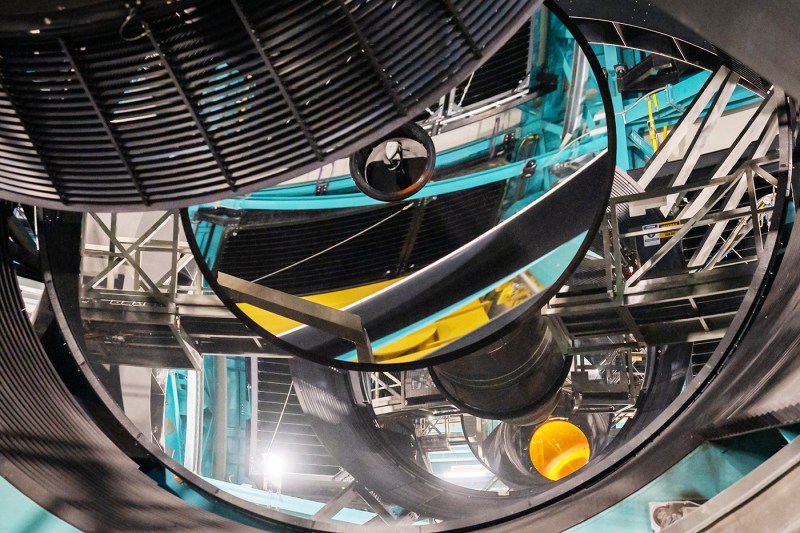Some of the largest objects in the night sky to view through a telescope are galaxies and supernova remnants, often many times larger in size than the moon but generally much less bright. Even so, they take up a mere fraction of the night sky, with even the largest planets in our solar system only taking up a few arcseconds and stars appearing as point sources. There are more things to look at in the sky than there are telescopes, regardless of size, so it might almost seem like an impossible task to see everything. Yet that’s what this new telescope in Chile aims to do.
The Vera C. Rubin Observatory plans to image the entire sky every few nights over a period lasting for ten years. This will allow astronomers to see the many ways the cosmos change with more data than has ever been available to them. The field of view of the telescope is about 3.5 degrees in diameter, so it needs to move often and quickly in order to take these images. At first glance the telescope looks like any other large, visible light telescope on the tops of the Andes, Mauna Kea, or the Canary Islands. But it has a huge motor to move it, as well as a large sensor which generates a 3200-megapixel image every 30 seconds.
In many ways the observatory’s telescope an imaging technology is only the first part of the project. A number of machine learning algorithms and other software solutions have been created to help astronomers sift through the huge amount of data the telescope is generating and find new irregularities in the data, from asteroids to supernovae. First light for the telescope was this month, June 2025, and some of the first images can be seen here. There have been a number of interesting astronomical observations underway lately even excluding the JWST. Take a look at this solar telescope which uses a new algorithm to take much higher resolution images than ever before.















I was a bit confused that hackaday wrote 30s for an image, while the article at science.org mentions 3s.
The website of the Vera C Rubin observatory itself has more details about the camera:
https://rubinobservatory.org/explore/how-rubin-works/technology/camera
It’s got a bunch of different filters, and stars don’t change in color very quickly, so R, G, B (and other color filters) are taken in succession to create a full picture. The camera also has 189 separate CCD sensors
( https://rubinobservatory.org/news/rubin-completes-comcam-tests ) and there are gaps between the sensors. How do you create a complete image from that? Is the “sensor carrier” rotated or shifted in between exposures?
And how much of the night sky is actually visible from Chile? To be able to look both direct North and South, you’d have to be on a mountain top quite close to the equator, (Telescope observations near the horizon also tend t be hazy because of the long light path through the atmosphere) And the area that’s visible during night hours also shifts during a year with the earth orbit around the sun.
“The high desert skies above Cerro Pachón, a Chilean mountain that is home to the new Vera C. Rubin Observatory, are generally dry and clear, perfect for observing.”
I watched the first light event. The images were awesome. They also found over 2000 asteroids during the first light event.
The VCRO (aka LSST) in essence is PanSTARRS on steroids. I was working at MHPCC when we were asked to look at options for PanSTARRS to process all of a night’s sky scan data before the next night. Its camera was my first exposure to the idea of building a big detector from many CCD elements, and living with the gaps between the individual elements. IIRC this is mitigated during NEO search by a streak detection algorithm.
I assume the much newer VCRO camera’s gaps (0.5mm between “rafts”, 0.25mm between sensors) is less than PanSTARRS, but apparently not too much less, given that the PanSTARRS fill factor is 90% compared >90% for the VCRO.
I think it’s a bit iffy that we had that issue with the rotation of galaxies and redshift first noticed from around 1949 through the 1950’s and we STILL haven’t reached a somewhat decent reliable answer.
I think we need to do like android’s team did with their ‘project whatever’ and do a really focused concerted effort to get answers on this specific thing. Because this is just embarrassing.
Get an agreement what we have confirmed with observation, close the parts where there is uncertainty in such observations, then decide what observations are needed to lock it down and then do such additional observations. Publish it as a unified report of the data (not wild conjecture) that can freely be accessed by all scientist and schools and universities et cetera.
And just to be sure, when I say publish I don’t mean mainstream news or youtube.